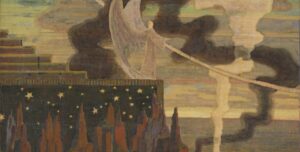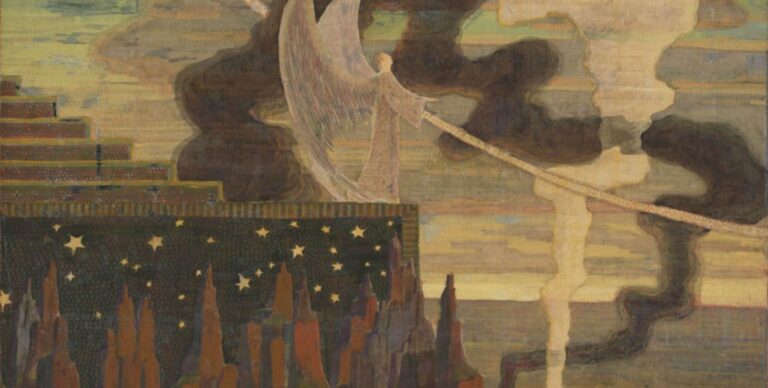The Ceffyl Dŵr is a creature from Welsh folklore, known as the “Water Horse”, a ghostly horse-like being which haunts rivers, lakes, and misty moors, luring unsuspecting victims to their doom. It’s often described as an ethereal, shape-shifting entity that can appear solid one moment and then dissolve into mist or water the next.
The creature typically takes the form of a beautiful, sleek horse. At first glance, it may seem like an ordinary creature with a glossy coat and strong build, but its hooves often leave no prints, even in the softest mud, and its eyes can glow with an eerie light. In some tales, the Ceffyl Dŵr’s mane and tail appear to be made of water or mist.
The Ceffyl Dŵr’s ability to shape-shift adds to the danger of encountering one: it can vanish into fog or mist, appearing and disappearing at will, leaving no trace behind. As many folklore shapeshifters, it’s a malevolent creature with a penchant for trickery: it uses its beauty and grace to lure people into danger, appearing to travellers near water sources, especially at night or in the early morning when the mists are thick, and visibility is low.
Once someone attempts to mount the Ceffyl Dŵr, believing it to be a friendly horse, the creature reveals its true nature. It gallops toward the nearest body of water, carrying its victim with it. As the rider realizes they are in danger and tries to dismount, the Ceffyl Dŵr will suddenly rise into the air, soaring above the water before diving into the depths, dragging the unfortunate soul down with it. Victims of the Ceffyl Dŵr are never seen again.
Some other versions of the legend describe the Ceffyl Dŵr as a guardian of sacred or cursed waters, attacking those who dare to disturb the peace of these places. Others portray it as a lonely, vengeful spirit, forever bound to the water it haunts, seeking to pull the living into the realm of the dead. Some other times, it’s a creature of mystery and sorrow, the ghost of a horse that drowned in a river or lake, cursed to remain in the water forever, repeating the circumstances of its death with each new victim it claims.
One of the most famous tales involving the Ceffyl Dŵr comes from the region of Brecon in South Wales. The story tells of a young woman who encountered a beautiful white horse drinking from a nearby stream while crossing the moors at dusk. The horse seemed gentle and inviting, and tired from her journey, the woman decided to ride it back to her village. As soon as she mounted the horse, it began to gallop uncontrollably, racing toward the river at an unnatural speed. Realizing too late that this was no ordinary horse, the woman tried to dismount, but the Ceffyl Dŵr took to the air, soaring above the water before plunging into the river with her. She was never seen again.
Another legend tells of a fisherman who encountered the Ceffyl Dŵr near Llyn y Fan Fach, a lake in Carmarthenshire. The fisherman saw a magnificent horse by the water’s edge and approached it, hoping to capture it and take it home. As he reached out to touch the horse, it dissolved into mist, enveloping him. The mist thickened, and the fisherman became disoriented, losing his way. When the mist finally cleared, the fisherman found himself standing waist-deep in the freezing lake, miles from where he had started, with no memory of how he had gotten there. He barely escaped with his life, and he told others of his encounter, cautioning them to stay away from the misty shores of the lake.
Picture in the header: Misty Lake by Olga Yakubouskaya





No Comments